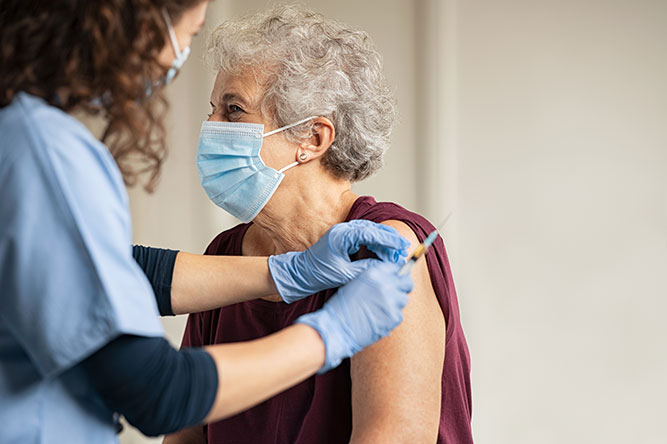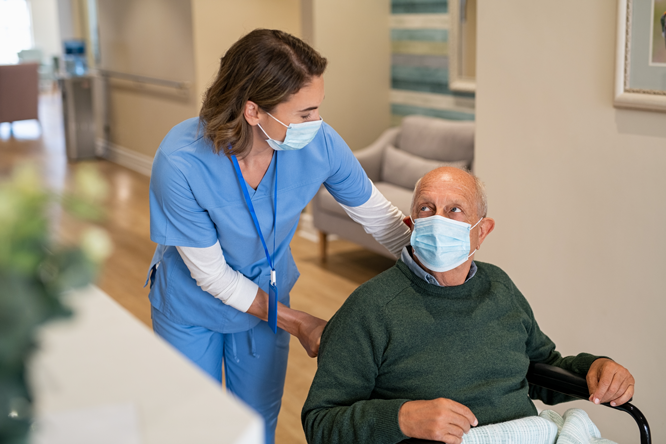
While we are all heartened by the emergency approval of two COVID-19 vaccines and the prospect of several more on the way, there are considerable challenges ahead for long-term care (LTC) residents and the providers who care for them.
COVID-19 cases are at an all-time high in many parts of the country. In December, occupancy in nursing homes dipped below 70 percent, while senior housing occupancy reached an all-time low at 80 percent for the fourth quarter of 2020. The ill effects of isolation and depression among residents and their families, not to mention the loss of life, are incalculable.
Now more than ever, providers need to understand and address the risks immediately before them and execute accordingly. Two issues rise to the top of a big pile: maximizing staff and resident acceptance of the vaccine and repeat rapid testing of asymptomatic staff.
Maximizing COVID-19 Vaccine Acceptance
Regarding COVID-19 vaccine acceptance, initial anecdotal data indicates that staff vaccine acceptance is in the 30–60 percent range, while resident uptake is significantly higher. Skepticism runs deep in some quarters, with concerns that the vaccine was rushed and that the long-term consequences are unknown. The Centers for Disease Control and Prevention (CDC) and others have put out much information to dispel these claims, and hopefully some of the hesitancy will be reduced after provider staff see others take the COVID-19 vaccine.
Unfortunately, there are some problems with waiting for folks to get on board. The COVID-19 vaccine is a two-dose process, and the longer it takes for a community to achieve herd immunity, the more risk there is for outbreaks, virus mutations, and prolonged visitor restrictions. Dr. Fauci recently speculated that, due to the contagiousness of the virus, the percentage of persons needing to be vaccinated or have had COVID-19 needs to be 85–90 percent to achieve herd immunity. Others dispute this, and quite frankly, we may not really know until more definitive studies are completed.
Since the LTC pharmacy vaccination clinic is a three-visit process, those staff who skipped the first visit really need to get their first dose at the second clinic so that they can receive their final dose at the third clinic. A separate but related issue is that even after the second LTC pharmacy vaccination clinic, communities will be hiring new staff and admitting new residents. Providers and the federal government need a clear game plan to address staff and resident turnover.
There are also at-risk persons who cannot take the COVID-19 vaccine due to medical contraindications. Finally, even once vaccinated, it is only clear that vaccinated persons have significantly less likelihood of progressing to serious illness; the possibility remains that vaccinated persons may still transmit COVID-19 to other persons, though the extent of this is not yet known.
Repeat Rapid Testing of Asymptomatic Staff
Even in a best-case scenario, it may be some time before we are at herd immunity. This brings us to the importance of all the other measures to prevent infection, most notably the testing and screening of asymptomatic staff.
Over the last nine months, one voice has been especially clear on the importance of repeat rapid antigen testing: Dr. Michael Mina, an epidemiologist from Harvard T.H. Chan School of Public Health. He has been a proponent of making antigen test strips widely available for persons to test themselves at home on an ongoing repeat basis. If done widely, his research indicates that the virus could be eradicated in a matter of months. He is advocating that rapid antigen tests need to be used as a widespread public health screening tool.
Dr. Mina’s argument takes a moment to digest. A criticism of rapid antigen tests is that they are less sensitive than polymerase chain reaction (PCR) tests, leading to false negatives in some instances. Dr. Mina points out that rapid antigen tests are very sensitive precisely when persons have a high viral load, which is when they are the most transmissible. These highly transmissible persons are often not symptomatic, as they may be in the early part of the infection process, or they may be part of a large cohort of infected individuals that does not ever develop noticeable symptoms. Unfortunately, these are the individuals who are bringing the virus into nursing homes and congregate senior living environments.
While PCR testing may be more sensitive, it unfortunately does not give a rapid result. If an asymptomatic staff person was tested by PCR on Monday and exposed to COVID-19 several days earlier, and if the community does not get the PCR test back until the subsequent Wednesday or Thursday, that staff person could well be at risk of infecting other staff or residents for at least a week. Compounding concerns about untimeliness of PCR tests is a recent warning by the Food and Drug Administration (FDA) that not all PCR tests may be picking up new variants of COVID-19.
So, Dr. Mina suggests widespread, repeat rapid antigen testing in order to intercept asymptomatic people when they are transmissible. Repeating the testing on the order of twice a week or more is key to identifying the relatively short windows when asymptomatic infected persons are highly transmissible.
Implications for LTC Providers
Many LTC providers are exclusively relying on PCR testing because they believe it is the most sensitive test, and they may be in states that have programs or regulatory structures that implicitly encourage primary reliance on PCR testing. In many cases, providers are stretched thin and only accomplishing the regulatory minimums for testing.
Nursing homes and assisted living communities are ideally suited to implement a program of routine, repeat rapid antigen testing of asymptomatic staff as an adjunct to a PCR-based strategy and should strongly consider this as we proceed through the vaccine transition period over the next few months—especially if they are in an area with high outbreak in the surrounding community. These providers should also consider routine, repeat rapid antigen testing over and above required regulatory minimums for staff who have opted out of vaccination and frequent PCR testing for residents who could not otherwise be vaccinated.
The CDC has recently issued updated guidance, “Considerations for Interpretation of Antigen Tests in Long-Term Care Facilities,” which contains a helpful flow chart on how to treat symptomatic vs. asymptomatic patients and what to do with test results when antigen and PCR testing disagree.
If, after doing repeat rapid antigen testing for asymptomatic staff, the community is still identifying positive cases with residents, then a root cause analysis needs to be conducted to identify opportunities for improvement in screening, personal protective equipment (PPE) use, testing procedures, or other areas.
The good news is that the U.S. Department of Health and Human Services (HHS) recently announced that it renewed a contract to continue distribution of Abbott BinaxNOW test cards through March 2021. These rapid antigen test cards are being shipped directly to nursing homes, assisted living communities, home health, and hospice agencies based on county positivity rates in the surrounding community. These tests can be used for routine testing of staff according to Centers for Medicare & Medicaid Services (CMS) requirements, and they can also be used to test LTC residents or visitors, hospice patients, or home health clients at the discretion of the provider. These test kits are well-suited for a supplementary test regimen as described above.
Hope for the Future with Expanded Technological Solutions
There may also be good news on the horizon in terms of technological solutions for improved screening of asymptomatic staff and visitors. Massachusetts Institute of Technology (MIT) researchers recently published a study of a computer-based application that identifies asymptomatic persons with COVID-19 infection by analyzing their recorded forced coughs uploaded to a server. This technology is based on artificial intelligence and was originally designed to identify persons facing early-stage Alzheimer’s disease. This is being developed into a smartphone application. The next step is to test the application on a larger, more diverse population and to seek approval with the FDA. This would potentially be an ideal screening tool for LTC providers. The time frame and viability for this type of solution is unclear.
In Summary
In the meantime, top priorities for providers should be increased rollout of vaccination, a robust process to identify COVID-19 positive individuals, and superior infection control.
As a national leader in health care management and consulting services, Health Dimensions Group (HDG) is uniquely positioned to assist providers with COVID-19 response, vaccination, testing strategies, or preparation for the future. For more information on how HDG has helped with COVID-19 outbreaks in other senior care and living communities, or to discuss options for providing care for your residents, please contact us at info@hdgi1.com or 763.537.5700.












